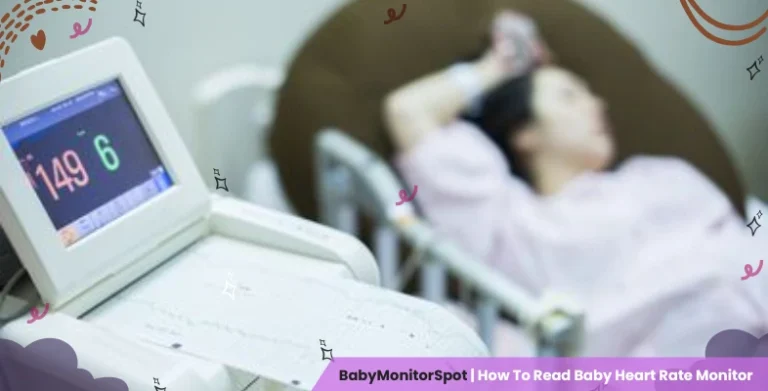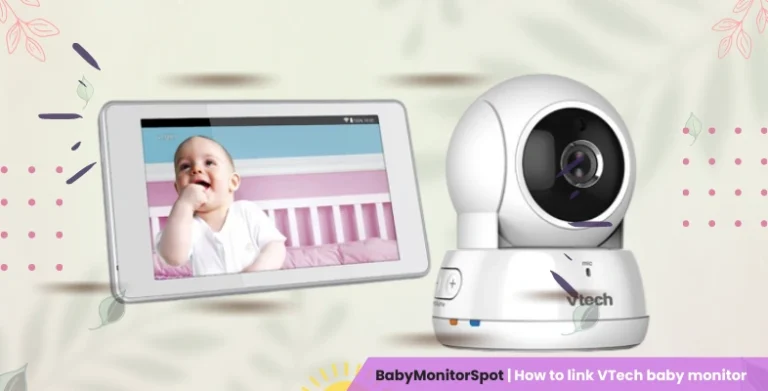How To Read Baby Heart Rate Monitor? 2 Main Types – Full Guide 2023
- Ejaz
- Last Updated | July 27, 2024

Heart rate monitor graphs often show the heart rate and contractions separately. A person’s heartbeat changes depending on whether she’s sleeping or awake. A woman with contractions also has a faster heartbeat than someone who isn’t about to give birth.
Your doctor may monitor your heartbeat during late pregnancy and labor because the average fetal heart rate is 110-160 bpm. Your baby may be responsive to conditions inside your womb. A fast fetal heart rate may indicate your baby isn’t getting enough oxygen. An abnormally slow fetal heart rate may signify other complications.
In this article, you will read how to read a baby heart rate monitor, 2 main types of baby heart rate monitoring, and their complete process. And also how to check a baby’s heart rate at home and some important FAQs.
2 Main Types of Baby Heart Rate Monitoring.
1. External Fetal Heart Monitoring
A Doppler ultrasound device records babies’ heartbeats during the external fetal heart monitoring. It is often used to count the baby’s heart rate during prenatal visits. It may also be helpful when a woman has contractions while giving birth.
A healthcare provider checks your baby’s heartbeat by using an ultrasound device. The transducer (probe) attached to your belly sends sound waves that bounce off your baby’s body.
The waves are then transformed into digital images that show your baby’s beating heart. These images are examined by a doctor who prints them out on paper.
2. Internal Fetal Heart Monitoring
The electrode is placed straight on the fetal scalp via the cervix in the internal fetal heart monitor. This method gives you more accurate results than other methods. Because babies move around while being monitored, this method makes sure that the baby doesn’t get any shocks or burns.
What happens during baby heart rate monitoring?
Heart monitor testing may be performed in an outpatient setting or during a hospital stay. It may involve periodic tests or continuous monitoring. You may receive a cardiotocograph (CTG) or ultrasound to check fetal movement.
Heart rate monitoring usually follows this process.
What is the Process of External heart monitoring?
- Depending on the procedure, you may be asked to take off your clothes and put on a hospital gown.
- Put your head down on the exam table.
- Your abdomen needs to be protected by a thin layer of clear gel.
- A provider will touch your skin to check out the fetal heartbeat. The provider may move the transducer around until they hear the fetal heartbeat. You’ll be able to listen to the fetal heartbeat through an electronic device such as a Doppler or a monitor.
- During labor, you should be checked frequently by an obstetrician or midwife. Your baby’s heartbeat needs to be checked regularly during work. You should also report any unusual symptoms to your doctor.
- The providers will connect the transducers to the monitors with cables for continuous electronic monitoring. Elastic belts will be used to hold them in place.
- A baby monitor records the fetal heartbeat. This information is then displayed on a computer screen. The printout shows the fetal heartbeat.
- It would be best if you avoided this because you could feel too much pressure while lying down.
- Once the procedure is done, he wipes away the gel.
What is the process of Internal Fetal heart monitoring?
- You will be asked to remove some of your clothes. You will then put on a hospital gown.
- You will lie down on an examination table. A nurse will examine your breasts and vagina. She may use a speculum to see inside of you. Then she will feel around inside of you.
- A vaginal exam involves inserting your fingers into your vagina and feeling around to check if there are any signs of infection or a baby inside. Your healthcare provider will use a glove to help prevent infections.
- Your healthcare provider must perform a D&C (Dilation & Curettage) procedure if you need an abortion. A D&C is performed by breaking up the amniotic sac around the baby. When this happens, there will be some amount of blood loss.
- Your healthcare provider will use gloved fingers to touch your baby’s head.
- A doctor inserts a catheter into a woman’s vagina during childbirth. She then puts a tiny wire at the tip of the catheter on her child’s head. It allows doctors to monitor the baby while giving birth.
- A doctor removes the catheter and tells the mother she should use a new catheter every time.
- A provider will connect the wire from a monitor cable to a band around the patient’s leg, then secure it by wrapping it with tape.
- You should avoid getting up too early since you might wake your baby.
- The baby should be removed from the mother after birth.
How to monitor a baby heartbeat at home?
Your baby is growing every day during the pregnancy. It would help if you cared for yourself because you might get sick or even give birth early. Pregnancy test kits are handy tools for checking on your baby inside you.
A fetal doppler is used to measure fetal heart rate by listening for blood flow sounds within the fetus. Doctors usually warm the gel before using them. Fetuses are very vulnerable during the early stages of development. A fetus gets its heartbeat detected by using an ultrasound machine.
With an at-home fetal doppler, you can rest easy knowing that you aren’t alone in your concerns. You can also ensure that your baby gets enough oxygen by checking the heartbeat throughout the day. At night, when you’re sleeping, the doppler can be used to check if there are any changes in the heartbeat.
Home Fetal Doppler Vs The One at the Doctor’s Office
A home fetal doppler cannot replace doctors’ appointments. It should be used as an intermediate step before visiting the doctor. It shouldn’t be used instead for doctors’ appointments.
Home fetal doppler devices are often of poor quality. It may lead to inaccurate results. Doctors use medical-grade equipment, but there aren’t many options available.
Dopplers are devices that measure speed by using sound waves. The more precise the device, the better it works. But there are no laws or rules about how companies make these devices. So it would be best if you use caution when buying a doppler.
Your doctor or midwife is aware of all the sounds in your uterus. They’re also trained to recognize when things are concerning and know what’s expected.
How to Check Fetal Heart Tracings?
For EFM to be useful for detecting fetal distress, doctors and nurses in the hospital need to have accurate signal tracings. These tracings must then be interpreted correctly by medical personnel.
Reading EFM tracings is complex and requires some experience. Doctors and nurses use different interpretations when reading EFM tracings.
What can heart rate monitoring tell you about your baby?
The Heart monitor checks the baby’s heart rate during pregnancy to ensure everything is OK or not. It alerts you when your baby isn’t getting enough oxygen. You want your baby to stay healthy until birth.
A typical baby’s heartbeat is between 110 and 160 beats per minute. This output was generated using the following code:
Short bursts of acceleration of the heart rate of a newborn baby mean that they are receiving enough oxygen.
Heartbeat deceleration may be expected during labor.
A doctor explains why babies have trouble breathing when born. He may say that the umbilical cord might be too tight, or there may be an obstruction in the birth canal. It causes the baby to struggle to breathe and slowly inflates the lungs.
Your doctor suggests you change your labor positions. If your fetal heart rate indicates that your baby might be in danger, you should do this. If you need forceps or a vacuum to deliver your baby, your doctor recommends a cesarean.
What happens after heart rate monitoring?
Your doctor does not recommend taking special precautions after internal fetal heart monitoring. They will check your baby’s scalp for infection, bleeding, or a wound. The provider cleans the site with an antistatic solution.
Your healthcare provider may give you some additional instructions based on your condition.
Conclusion
Many things affect a mother’s health during childbirth, including her age, weight, diet, exercise habits, stress levels, sleep patterns, Etc. Technology can help but cannot replace a good doctor.
A fetal heart rate monitor (FHRM) should be used as part of the assessment when caring for a pregnant woman suspected of having an abnormal FHRM.
Fetal heart monitoring is a great tool; however, you should be careful about how much weight we place on fetal heart monitor results. A normal heartbeat doesn’t necessarily mean our child is healthy.
Latest Posts







2 thoughts on “How To Read Baby Heart Rate Monitor? 2 Main Types – Full Guide 2023”
You are welcome!
Keep visiting for new content
Welcome!
Appreciate your time to read the full guide.
I’m doing blogging for last 2 years.